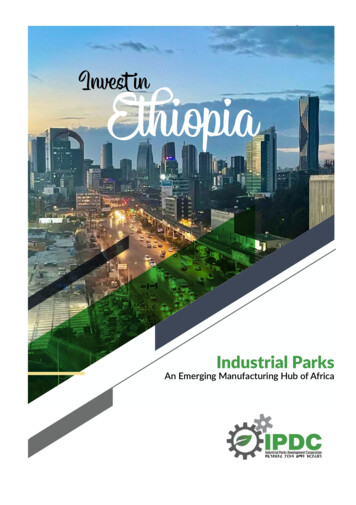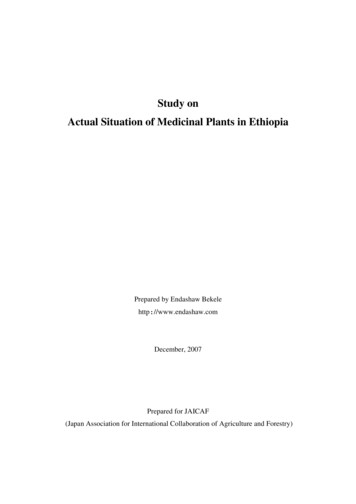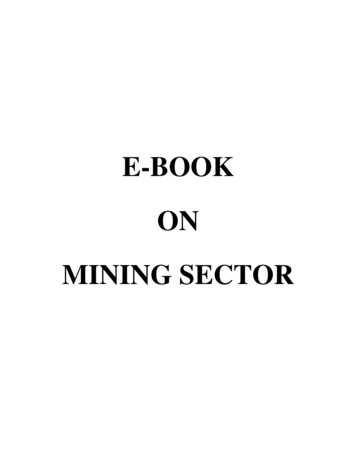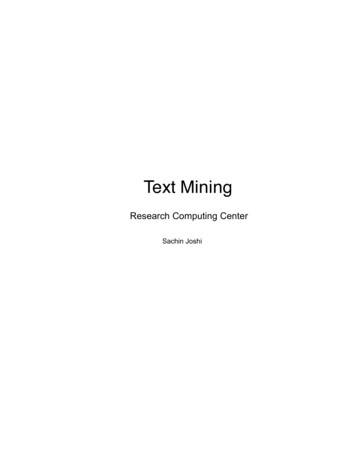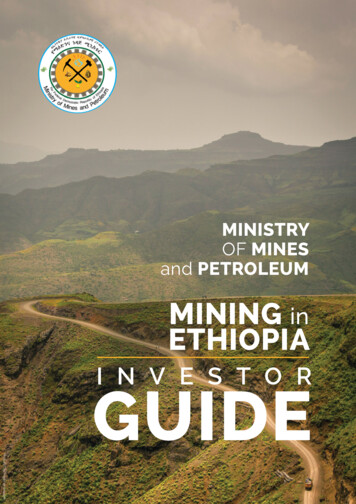
Transcription
MINISTRYOF MINESand PETROLEUMMINING inETHIOPIAI N V E S T O RPhoto by Clay Knight on UnsplashGUIDEINVESTOR GUIDE - MINING IN ETHIOPIA 1
CONTENTS6.5 ASSM licencing, legislation and regulations1.WELCOME TO OUR MINING INVESTOR GUIDE4656.5.1 Licencing462. QUICK GUIDE TO ETHIOPIA AS YOUR MINING DESTINATION OF CHOICE86.5.2 Royalties and taxes473. ETHIOPIA AT A GLANCE113.1 A soaring economy163.2 Getting to know the Growth and Transformation Plan II4. REFORMING THE MINING SECTOR4.1 National Plan for Job Creation5. WHAT YOU NEED TO KNOW ABOUT ETHIOPIA’S MINERALS5.1 Ethiopia’s geology5.1.1 About the GSE5.2 Ethiopia’s mineral potential6.6 Environment and safety regulations47166.6.1 Environmental Impact Assessments, rehabilitation fund andcommunity development48166.6.2 Environmental Impact Assessments48176.6.3 Environmental Impact Assessment guidelines49196.6.4 Regional Environmental Bureaus49216.6.5 Environmental management guidelines for artisanal miners50226.6.6 Safety regulations50226.6.7 Pollution506.7 Community engagement505.2.1 Gemstones255.2.2 Metallic minerals276.7.1 Community development505.2.3 Industrial minerals336.7.2 Overseeing the community development fund505.3 ASSM in Ethiopia6.8 Fiscal regime35515.3.1 Ethiopia’s Artisanal, Special and Small-Scale Mining National Strategy356.8.1 Fiscal incentives515.3.2 Artisanal mining, employment and the economy366.8.2 Taxation525.3.3 Improving market access and increasing earnings366.8.3 Mining operations incentives525.3.4 Profile of an artisanal miner in Ethiopia365.3.5 Prioritising women in the ASSM sector366.9 Land allocation527. DOING BUSINESS IN ETHIOPIA54387.1 Ethiopia’s Citizen Charter556.1 About the Ministry of Mines and Petroleum397.2 Visiting Ethiopia as an investor556.2 How to apply for a licence417.3 How to register your business566.3 Mining licence application process437.4 Investor protection596.4 About Ethiopia’s legal and regulatory framework437.4.1 Expropriation protection596. INVESTING IN ETHIOPIA’S MINING SECTOR6.4.1 Mining legislation and regulations447.4.2 Dispute settlement596.4.2 Tax457.4.3 Repatriation of funds596.4.3 Environment456.4.4 Commercial licencing458. IMPORTANT AGENCIES AND SUPPORTING INSTITUTIONS606.4.5 Human rights and civil societies458.1 Ethiopian Mineral, Petroleum and Bio-fuel Corporation606.4.6 Land use468.2 The Environment, Forest and Climate Change Commission606.4.7 Labour468.3 The Ethiopian Investment Commission628.4 Other relevant stakeholder institutions62INVESTOR GUIDE - MINING IN ETHIOPIA 7.5 Trade agreements with other countries and investment treaties259INVESTOR GUIDE - MINING IN ETHIOPIA 3
ACRONYMSASSMArtisanal and Small-Scale MinersCIRDICanadian International Resources and Development InstituteCOMESACommon Market for Eastern and Southern AfricaCFTAContinental Free Trade AreaE-EITIEthiopia’s Extractive Industry Transparency InitiativeEFCCCEnvironment, Forest and Climate Change CommissionEIAEnvironmental Impact AssessmentEICEthiopian Investment CommissionEMDSCEthiopian Mineral Development Share CompanyEMPBFCEthiopian Minerals, Petroleum and Bio-Fuel CorporationEPAEnvironmental Protection AgencyERCAEthiopian Revenues and Customs AuthorityGDPGross Domestic ProductGoEGovernment of EthiopiaGTPGrowth and Transformation PlanGSEGeological Survey of EthiopiaIGADIntergovernmental Authority on DevelopmentMoMAMemorandum of AgreementMoMPMinistry of Mines and PetroleumMoTMinistry of TradePLCPrivate Limited CompanySMEsSmall and Medium EnterprisesSDGsSustainable Development GoalsSOPSulphur of PotashSUMMSupporting the Ministry of Mines Project EthiopiaTINTax Identification NumberVMSVolcanogenic Massive SulfiedUNDPUnited Nations Development ProgrammeWELCOME TO OURINVESTOR GUIDE - MINING IN ETHIOPIA MININGINVESTORGUIDE4INVESTOR GUIDE - MINING IN ETHIOPIA 5
WELCOME TO OURMININGINVESTORGUIDEEthiopia is the ideal mining destination forcompanies looking to invest in a high-potentialmining jurisdiction. With impressive mineralresources and a government committed toexecuting ambitious economic reforms, thebuilding blocks are in place to create a worldclass mining sector.This guide is designed to provide the investor with a clear picture of Ethiopia’sextraordinary mineral resources, their geology, and the nature of the opportunityfor each commodity. It clearly sets out the legal and regulatory frameworks formining and petroleum in Ethiopia. It also outlines the different players in Ethiopia’smining sector, federal and regional, and their respective roles.Ethiopia’s mining sector has undertaken a major reform programme in recentyears. The reform is designed to make it easier than ever to invest in Ethiopia,encourage exploration and mining, and unlock the sector’s full potential and value.The reform includes geodata management, transparency and ease of licensingprocess and the artisanal mining sector among others. Read more about thisimportant work later in the guide.The Ministry of Mines and Petroleum (MoMP) is the first port of call for all investorsinterested in Ethiopia’s mining and hydrocarbon sectors. The MoMP can direct youto the most up-to-date geodata available, guide you to the right legislation andregulations for your business, and help you apply for any licences required. TheMoMP also provides straightforward guidance on how to go about investing inEthiopia’s abundant natural resources.INVESTOR GUIDE - MINING IN ETHIOPIA 6INVESTOR GUIDE - MINING IN ETHIOPIA 7
022.A QUICK GUIDE TOETHIOPIA AS YOUR MININGDESTINATION OF CHOICEA QUICK GUIDE TOETHIOPIAAS YOURMININGDESTINATIONOF CHOICEThe country covers 1.14 million square kilometres and has apopulation of 105 million people, making it Africa’s secondmost populous nation.Ethiopia has enjoyed international acclaim for its impressive and sustained economic growth and thevisionary political leadership of Nobel Laureate, Prime Minister Dr Abiy Ahmed. Mining reform is high onPrime Minister Abiy’s agenda, who intends for mining to comprise 10% of the country’s Gross DomesticProduct (GDP) by 2025. To achieve this, the Prime Minister has launched the ‘Homegrown EconomicReform Agenda’, which seeks to implement the following macroeconomic, sectoral and structuralreforms.Homegrown Economic Reform AgendaMACROECONOMICREFORMSMINING REFORMS2INVESTOR GUIDE - MINING IN ETHIOPIA 8 Strengthening public sector finances Correcting foreign currency imbalances Controlling inflation Safeguarding financial stability Improving access to finance and developing capital markets Formalising and supporting artisanal and small-scale mining Reviewing gold pricing to reduce incentives for illicit trade Addressing political and legal issues with local communities andincentivising miners to engage and invest in local communities Addressing technical and institutional barriers against large-scale miningprojects Developing policies and institutional capacities to create a sustainable,inclusive mining sector with strengthened geological information and adiversified product base with a focus on industrial inputINVESTOR GUIDE - MINING IN ETHIOPIA 9
Ethiopia has a history in mining, dating back tomore1 thanthree millennia,especiallyin gold.ABUNDANTMINERALPOTENTIALin the sector through one office - the Grants andInternational Cooperation Office at the Ministry ofMines and Petroleum.Apart from gold, Ethiopia’s mineral potentialis vast. With known occurrences of more than30 metallic, industrial, agro- and constructionminerals as well as rare gemstones.The following information is available topotential investors in the Ethiopian mineralsector:Ethiopia is also home to one of the oldestgeological surveys on the continent, theGeological Survey of Ethiopia (GSE). Dataprovided by the GSE make both exploration andthe acquisition of brownfield projects easier forinvestors.Available maps include:Geoscience and hydro-geologyAirborne geophysicsGround gravityEngineering geology and geohazardMineral exploration2 ONE-STOP-SHOPRegulatory environmentLegal environment and complianceEconomic environmentMining/Petroleum Investment GuidePriority sub-sectors, designation andlocalisationEnvironmental Impact AssessmentMining/Petroleum licencing and permitsInvestment promotionVisa and duty-free process facilitationBrokerage with local entrepreneurs in themining sectorThe MoMP also launched its newly upgradedwebsite, which showcases the mineraldevelopment vision for Ethiopia.Summary of provisions for investorsLEGISLATIVEFRAMEWORK ANDFISCAL REGIMEThe one-stop-shop coordinates and facilitatesaccess to relevant government directoratesand entities involved in regulatory, registration,permits and licencing. It aims to ensure thatinvestors can go to the MoMP (physically oronline) and receive all guidelines, administrativeinformation and approvals they need to investINVESTOR GUIDE - MINING IN ETHIOPIA 10 Attractive royalties-4% for industrial minerals5% for metallic minerals7% for goldPetroleum royalties are negotiable Formalising and supporting artisanal and small-scale mining Retention of portions of foreign currency earnings and remittanceof profits, dividends, principal and interest on a foreign loan outof Ethiopia Exemption from customs duties and taxes on equipment,machinery and vehicles necessary for mining operations 100% cost recovery for companies that successfully engage inmining operations (Tax Proclamation, Chapter 4)Guarantee licencee's right to sell minerals and petroleum productslocally or abroadDISPUTE RESOLUTIONProvide for dispute settlement through negotiation and arbitration3 INCENTIVESThe investment policy in Ethiopia is generallyestablished under the principles and practices ofa free market-driven economy. The governmenthas enacted a competitive legal and fiscal regimethat has attracted many local and foreign miningcompanies, from exploration through to miningactivities. The government provides a numberof incentives to encourage private investmentand promote the inflow of foreign capital andtechnology into Ethiopia. The incentives are bothfiscal and non-fiscal, covering customs dutyexemptions, income tax exemptions and exportincentives provided to both domestic and foreigninvestors.25% corporate tax rate and permits 10 years’ loss carry-forwardMINERAL MARKETINGOWNERSHIPIn January 2020, 16 public and private officessigned an agreement to offer a one-stop-shopservice. Key ministries include Revenue, Tradeand Industry, Agriculture, Science and Innovation,Transport, and Mines and Petroleum (MoMP).This system is key to increasing Ethiopia’s tradecompetitiveness and it will help offices to deliversimple, predictable, efficient and fast services. Itwill increase revenue and satisfaction of clients,reduce corruption, bring transparency andencourage export trade. 55% government equity for minerals Negotiable for petroleumINVESTOR INCENTIVESMARKET FREEDOMCOST RECOVERYCompany or mining licence holder has right to sell mineralsdomestically or overseas All mineral exploration or pre-production costs are 100%recoverable 100% recoverable costs with a ceiling of 65 to 70%EXEMPTION FROMCUSTOMS DUTIESAND TAXESThe mining law provides exemption from customs duties and taxeson equipment, machinery, vehicles and spare parts necessary for themineral operations for mineral and petroleum operations (please referto petroleum and mineral laws on customs duties and taxes)OPENING OF THEFOREIGN CURRENCYACCOUNT IN ETHIOPIAAs per the mining law of the National Bank of Ethiopia, the openingand operation of a foreign currency account in Ethiopia is guaranteedINVESTOR GUIDE - MINING IN ETHIOPIA 11
4 delivery-oriented governmentEthiopia is rapidly executing high-value infrastructureinvestments, carefully designed to give the mining sector thespace it needs to grow. These investments ensure that miningcompanies will have the infrastructure they need to mine atscale, access global markets, and import production inputsquickly and smoothly.EnergyThe 1,870 MW Gibe III hydropower project, which doubled Ethiopia’s electricity output, was completed in2016. Ethiopia is also developing what will be Africa’s biggest hydroelectric power plant - the 6,000 MWGrand Renaissance Dam. This is due for completion in 2022.RailFurther expansion is underway with a 656 km rail line connecting Ethiopia to the port of neighbouringDjibouti.RoadBetween 2010 and 2015, Ethiopia’s road network more than doubled to reach 110,414 km.AIREthiopian Airlines is Africa’s largest carrier with access to 120 international destinations, and Addis Ababaairport is now the largest hub on the continent.Since 2005, there have been significant improvements in access to electricity, potable water and roads(see chart below), which is decreasing Ethiopia’s poverty headcount ratio.IMPACT OF INFRASTRUCTURE INVESTMENT03ETHIOPIAAT AGLANCEPOVERTY HEADCOUNT RATIO ATNATIONAL POVERTY LINES (% OF ess toelectricity(% ofpopulation)Access topotable water(% ofpopulation)Length of allweather roads(1000 km)200420102015INVESTOR GUIDE - MINING IN ETHIOPIA 12INVESTOR GUIDE - MINING IN ETHIOPIA 13
3.3.2ETHIOPIA AT A GLANCEEthiopia is strategically located in the Horn of Africa, giving itprime transport links to key export markets.GTP II and Ethiopia’s mining sectorThe GTP II major goal is to realise the national vision of becoming a lower middle-income country by2025 - achieved by sustaining rapid broad-based and inclusive economic growth, which accelerateseconomic transformation.The GTP II outlines the Government of Ethiopia’s deliberate interventions to increase the mining sector’srevenues to USD3.7 billion by 2025. This includes strengthening the implementation capacity of theMinistry and regional states, attracting reputable and competent investors by undertaking internationalstandard promotion work and funding the provision of reliable geological survey data.To achieve this, the GoE will drive an import-substitution agenda by developing minerals that canbe used as inputs for local industries and value-addition. Bio-fuel production and promotion of thedownstream petroleum industry will also be prioritised. Reducing environmental impact of the sector willbe central as will setting standards and regulations in fuel extraction, blending, storing, transporting anddistribution processes in the country.TigrayAfarAmharaThe plan has four pillars:Benishangul-GumuzDire DawaHararAddis AbabaGambelaGDP GROWTH (ANNUAL %)16To strengthen Ethiopia’s democratic institutions.1000GDP PER CAPITA (CURRENT US ), RHS14800121060084006420020INVESTOR GUIDE - MINING IN ETHIOPIA 142018201720162015201420132012Official language: Amharic201102010Government: Federal Democratic Republic 9 National Regional States 2 Federally Chartered cities4 Political stability:GDP PERFORMANCE2009Population: 105 millionEthiopia is considered one of the world’s mostconsistently high-performing economies, havingregistered an average GDP growth of 9% over thepast decade. Due in large to Ethiopia’s increasedindustrial output over that same period, itsperformance is planned and documented throughthe Growth and Transformation Plan (GTP), now inits second phase, the GTP II. The country’s stateled growth and development programme is nowmostly supported by the Homegrown EconomicReform Agenda (September 2019).2008Capital City: Addis AbabaA GROWING economymanufacturing:To develop domestic manufacturing,engineering and fabrication capacity which willimprove productivity, quality and internationalcompetitiveness. It also seeks to spur structuraltransformation to reposition Ethiopia as aregional leader in technological innovation andmanufacturing.2007Surface Area: 1.14 million km23.12 Regional hub for innovation and2004Ethiopia shares its boundary with the Northand South Sudan on the west, Somalia andDjibouti on the East, Eritrea on the Northand northwest and Kenya on the South.SomaliTo build upon and solidify the ongoing publicmobilisation and organised participation. Thisis to ensure the Ethiopian public become bothowners and beneficiaries of the outcomes ofEthiopia’s development.2006Southern Nations,Nationalities andPeoples3 Public participation and local ownership:2005Oromia1Lower middle-income economy:To achieve and maintain a real GDP growthrate of 11% within a stable macroeconomicenvironment.INVESTOR GUIDE - MINING IN ETHIOPIA 15
4.04REFORMINGTHE MINING SECTORThe Government of Ethiopia has set out a clear “Pathwayto Prosperity” through the new Homegrown EconomicReform Agenda, enabling Ethiopia to reach the status ofa middle-income country by 2030.REFORMINGTHE MININGSECTORThe goe has laid out clear ambitions for the mining sector:Amount of foreign exchange earned through export and import substitution increasing fromUS 265 million to US 17 billionAmount of local income earned from the sector increasing fromUS 400 million to US 90 billionNumber of FDI companies in the sector increasing fromUS 160 million to US 500 MillionNumber of quality jobs created in the sector organisations, companies and smes increasing from200, 000 to 1,6 MillionThe reform programme is focused on:1.2.3.4.5.INVESTOR GUIDE - MINING IN ETHIOPIA 16Implementing strategy and improving policyRevising the legal frameworkDeveloping institutional capacityDeveloping human resourcesEnhancing facilitation through information and technologyINVESTOR GUIDE - MINING IN ETHIOPIA 17
4.1National Plan for Job CreationTHE CASE FOR MINING SECTOR REFORM FOCUSES ON FIVE AREAS:Ethiopia’s National Plan for Job Creation (2020–2025) targets mining as a key sector to achieve its goal tocreate 14 million jobs by 2025, to absorb the currently unemployed and to ensure that jobs are waitingfor new entrants to the labour market.Mining has untapped potential in Ethiopia due to several institutional and technical constraints. Strategiesto improve pricing, formalise Artisanal and Small-Scale Miners (ASSM) miners and improve large-scaleminers’ relationships with local communities in the sector are underway to unlock the sector’s potentialfor direct and indirect job creation.Reforms in Ethiopia’s mining sector are well underway. MoMP is already several years into its ownambitious reform programme.Strategy 1Building a robust policy framework and anenabling environment by formalising ASM;Strategy 3Designing tailor-made skills developmentprogrammes, by:Providing government support for businessdevelopment;Creating a fellowship programme targetingprofessionals in the mining sector;Enforcing the existing legal framework topromote artisanal miners;Developing SME skills and readiness toprovide auxiliary services and products tolarge-scale firms;Improving the ease of access to licencesand finance for SMEs, and large-scaleminers working in mining value-addition.Integrating training on mineral explorationmethodologies into business developmentsupport to formalise SMEs;Strategy 2Improving horizontal and vertical integration in themining sector, by:Promoting and marketing Ethiopia’s miningpotential to the international market;Improving access of artisanal miners tolicenced buyers, providing competitive pricesfor gold and similar precious stones;Providing vocational training in value-additionpractices.Strategy 4Designing and implementing innovative flagshipprojects/programmes (for instance - introducinglease capital for the purchase of equipment) aspart of formalisation support, and support geochemical atlas mapping.INTERVENTIONACTIVITIES UNDERWAYIMPLEMENTING STRATEGYAND IMPROVING POLICY Development of Mineral and National Petroleum PolicyFormalisation of ASSM activitiesREVISING THE LEGALFRAMEWORK Review of the Mining Operation Proclamation and RegulationsReview of the Petroleum Operation ProclamationReview of the Transaction of Precious Minerals Proclamation Restructuring of Ministry of Mines and Petroleum to improvecoordination between federal and regional mining bureaus,simplifying licencing processEstablishment of the Mineral Excellence CentreDEVELOPING HUMANRESOURCES Right-sizing of staff complement to attract and retain talentPartnering with higher education institutions to build capacityENHANCING FACILITATIONTHROUGH INFORMATIONAND TECHNOLOGY Operationalisation of a modern and sophisticated cadastre systemDigitisation of existing maps and existing dataDEVELOPINGINSTITUTIONALCAPACITYHighlights of the MoMP’s progress with reforms since 2016 include:1 Implementing strategy and improving policyDevelopment of a GIS portal and integration of geoscience data into the upgraded national cadastresystem.Refreshing Ethiopia’s Mineral Development Policy.Developing Ethiopia’s National Petroleum Policy.Delivering an ASSM national strategy roadmap, which will see the formalisation of the sector forbetter management.Streamlining federal and regional licences and licencing systems to improve consistency, viain-depth consultations with the regional mining bureaus.2 Revising the legal frameworkCompleting a substantive review of all legal instruments regulating the mining sector in Ethiopia.Developing a framework for a Gender Equality and Mainstreaming Strategy to integrate genderconcerns in policies, legislation, strategies, plans and budgets.Encouraging the formation of Micro, Smalland Medium Enterprises to aggregateartisanal miners’ production;Introducing an investor engagement strategy and one-stop-shop mechanism.3 Developing institutional capacityCreating incentives for artisanal minerssupplying to licenced buyers.Restructuring of organisational levels inside the MoMP and the GSE to meet current industry needsand enhance service delivery.Establishing the Mineral Excellence Centre at the MoMP and creating an e-learning/trainingplatform.INVESTOR GUIDE - MINING IN ETHIOPIA 18INVESTOR GUIDE - MINING IN ETHIOPIA 19
5.05ABOUTETHIOPIA’S MINERALSEthiopia’s terrain primarilyconsists of rocks fromfour geological periods:the Proterozoic, Mesozoic,Tertiary and iopia’s geologyThe oldest rocks to be found in Ethiopia are fromlate Proterozoic age (900-540Ma), and cover slightlyless than 25% of the country. Mainly, these rocks areexposed in the northern, western and southern partsof Ethiopia. A scattering of such rocks, however, can bealso found in Harar in the east.Ethiopia’s Proterozoic basement sits partly in theArabian-Nubian shield that continues north into Sudan,Egypt and Saudi Arabia and south into the MozambiqueBelt, which comprises much of the geological basementthroughout eastern and southern Africa.GEOLOGICAL MAP OF ETHIOPIAINVESTOR GUIDE - MINING IN ETHIOPIA 20INVESTOR GUIDE - MINING IN ETHIOPIA 21
Mesozoic (251-66Ma) and some slightly oldermarine, continental and sedimentary rocks coveranother 25% of the country. These Mesozoicformations include rocks like sandstone, shale,limestone and gypsum. Eastern Ethiopia containsexceptionally large areas of these kinds of rock most notably in the Ogaden Basin. There are alsotwo sedimentary basins in the centre and to thenorth of the country.The remaining 50% of the country is coveredby Tertiary (65 - 2.6Ma) and Quaternary (2.6Ma- present time) volcanic and sedimentaryrocks. These originate from the formation ofthe Ethiopian rift, a subsection of the greaterEast African rift. The Ethiopian rift runs fromnortheast to southwest across Ethiopia. As such,the Ethiopian highlands are underlain mainlyby thick sequences of flood basalt that erupted65-13 million years ago, while the rift valleyitself is covered mainly by Quaternary ( 2.6Ma)volcanic rocks and associated sedimentary rocks.Quaternary sediments also occur in other parts ofthe country and tertiary sediments in the far east.5.1.1 About the GSEThe Geological Survey of Ethiopia (GSE) is anautonomous institution, with accountabilityto the MoMP. It is responsible for carrying outbasic geological mapping, mineral explorationand related geological activities. The GSE alsoprovides services such as data dissemination,and drilling and laboratory analysis.We invite you to visit the GSE’s Data Catalogueonline where you can find the followinginformation:High-quality geological maps at 1:2000000scale (100% complete);Ground gravity maps at 1:500000 scale(100% complete);Geoscience and hydro-geology maps at1:250000 scale (100% complete);Engineering geology and geohazardmapping at 1:250000 (50.54% complete asof end 2019);Airborne geophysics maps (30% completeas of end 2019);Mineral exploration maps at various scales.The GSE is working to improve the quality of datait can make available to investors. Under theGTP II, the GSE aims to achieve the following by2025:To increase its airborne geophysics surveycoverage from 30% to 100%;To increase its geohazard study coverage(at a scale of 1:250,000) from the current 42%to 100%;To make rapid progress mapping the wholecountry at a scale of 1:100,000 (The GSEhas completely mapped Ethiopia at a scaleof 1:250,000);To geochemically map the entire country ata scale of 1:1,000,000 scale and provide aGlobal Geochemical Baseline.5.2The GSE was stablished in 1968 as a department,becoming autonomous in 1982 as the EthiopianInstitute of Geological Surveys (EIGS), beforefinally being established in its current form in2000. The GSE has completed a geologicaland hydro-geological mapping at a scale of1:250000, for the entire country, and identifiedseveral targets for metallic, industrial, energyand construction minerals. This work providesthe critical foundation for mineral exploration andmining development projects in Ethiopia. The GSEalso plays a role in developing critical skills in thefield of geo-science.Detailed information and maps of Ethiopia’s mineral potentialare available on the MoMP website. The meta data of themineral exploration reports, conducted by GSE and foreignexploration companies, can be obtained from GSE’s meta datacatalogue that is available online at: log.search#/homeMore interactive maps on the geology and mineral potential ofEthiopia will become available soon on GSE’s portal l#c organization&o modifiedPdf reports and various format maps will be available fordownload from: http://repository.gse.gov.et/home/The mining cadastre portal has an updated 1:2,000,000 scalegeological map of Ethiopia and mineral occurance points alongwith the various licences operated in the country. More updatedgeological maps at 1:250,000 scale and updated mineral pointswill be available soon on the dynamic map at: e.aspx?PageID a16a93007c58-4f81-9e5c-97e13b22b0c6GENERALISED GEOLOGICAL ANDINDUSTRIAL MINERAL MAP OF ETHIOPIAEthiopia’s mineral potentialEthiopia has known occurrences of more than 30minerals. These include:Metallic minerals (gold, platinum, iron, nickel,chromite and base metals);Energy minerals (lithium, graphite, tantalumand coal);Cement raw minerals (limestone, gypsum,clay, pumice);Fertiliser raw minerals (potash and phosphate);Ceramics raw minerals (kaolin, feldspar);Glass raw minerals (silica sand);Dimension stones (marble, granite,limestone, sandstone, diatomite, bentonite,soda ash, salt, graphite and sulphur);Gemstones (opals, emeralds, sapphires).INVESTOR GUIDE - MINING IN ETHIOPIA 22INVESTOR GUIDE - MINING IN ETHIOPIA 23
5.2.1 GemstonesCOMMODITY RESERVESUNITLOCATIONGold 200metric tonnesAround Adola, Myale, Metekel, Tulu kape, Dul, Odagodere,Benshangul, Akobo, TigrayCoal 360million metric tonnesAround Moye, Delbi, Yayu, Chilga, Gojeb, Mush, Sar wihakunzila, Wuchale, Haik, Dese, Mersa, Arjo, Mendi, Kindohalal, Morka, Jeren, LalosapoTantalum19435metric tonnesAround Adola/KenetichaPlatinum12.5metric tonnesAround Yubdo, OromiaIron68.4million metric tonnesAround Bikilal, Melka arba and others17million metric tonnesAround Adolametric tonnesAround Afar/ InkafalaNickelManganese207563Limestone 900million metric tonnesAround Mekele, Abay, Butajira, Ogaden, Denakil, Diredawa,HararGypsum57.4million metric tonnesAround Tigray, Oromia, AmharaClay21.6million metric tonnesAround Mossobo, Diredawa, Melka jebdu, Debrebirhan,BurayuPotash1.3billion metric tonnesAround AfarPhosphate181million metric tonnesAround Bikilal, Melka ArbaMarble100million metric tonnesAround Daletti, Mora, Baruda, Bullen, Hulakuni, TigrayGranite70million metric tonnesMost parts of the countrySilica sand3.4million metric tonnesMost parts of the countryFeldspar500thousand metrictonnesMost parts of the countryQuartz400thousand metrictonnesMost parts of the country2million metric tonnesMost parts of the countryKaolin 20million metric tonnesMost parts of the countryDatomite 120million metric tonnesMost parts of the countryBentonite172million metric tonnesMost parts of the countrySoda ash460million metric tonnesMost parts of the countrySalt4.3billion metric tonnesMost parts of the countrySulphur6million metric tonnesMost parts of the countryGraphite460thousand metrictonnesMost parts of the countryKyanite 10million metric tonnesMost parts of the countrymetric tonnesMost parts of the countryDolomiteTalc118,175Beautiful gemstones areloved and admired acrossthe globe, and Ethiopia hasthem in abundance. Thisincludes opal, emerald,sapphire, amazonite, amber,ruby, tourmaline, aquamarine,chrysoprase, peridot, andvarious types of quartz, agateand jasper.Ethiopia has become a significant producer ofopal, sapphire and emerald in recent years,bringing the total reported gems to over 40. Newdiscoveries are on the rise, including the recentcolour-change gem-quality chrome grossulargreen garnet reported in the Journal of Gemology(2018).The major strengths of the gemstone sectorof Ethiopia - aside from having great potentialand variety - includes increased popularityin the world market, growing tourism and anemerging middle-class. In addition, Governmentis committed to improve and reform the industrybased on international practice.One of the most striking varieties of opal,disco
INVESTOR GUIDE - MINING IN ETHIOPIA 2 INVESTOR GUIDE - MINING IN ETHIOPIA 3 1. WELCOME TO OUR MINING INVESTOR GUIDE 5 2. QUICK GUIDE TO ETHIOPIA AS YOUR MINING DESTINATION OF CHOICE 8 3. ETHIOPIA AT A GLANCE 11 3.1 A soaring economy 16 3.2 Getting to know the Growth and Transformation Plan II 16 4. REFORMING THE MINING SECTOR 16


